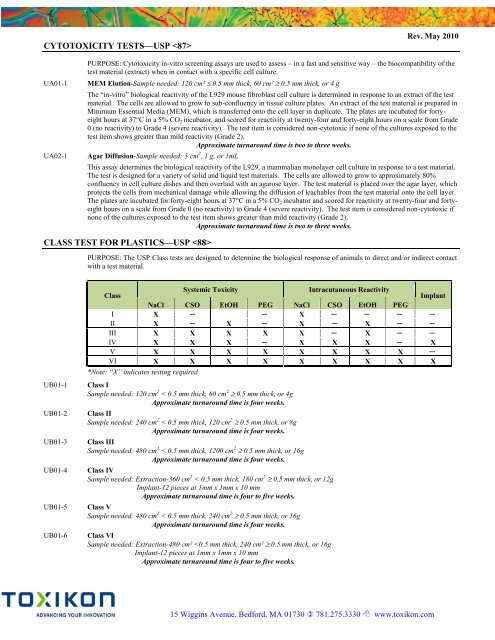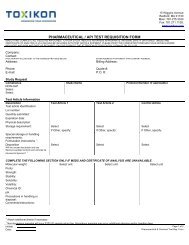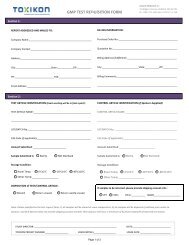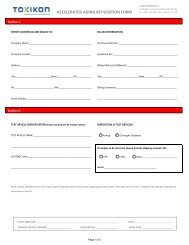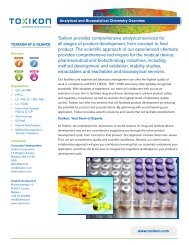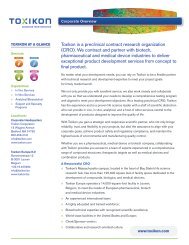Medical Device Testing Guide - Toxikon Corporation
Medical Device Testing Guide - Toxikon Corporation
Medical Device Testing Guide - Toxikon Corporation
Create successful ePaper yourself
Turn your PDF publications into a flip-book with our unique Google optimized e-Paper software.
CYTOTOXICITY TESTS—USP <br />
Rev. May 2010<br />
UA01-1<br />
UA02-1<br />
PURPOSE: Cytotoxicity in-vitro screening assays are used to assess – in a fast and sensitive way – the biocompatibility of the<br />
test material (extract) when in contact with a specific cell culture.<br />
MEM Elution-Sample needed: 120 cm² 0.5 mm thick, 60 cm² 0.5 mm thick, or 4 g<br />
The ―in-vitro‖ biological reactivity of the L929 mouse fibroblast cell culture is determined in response to an extract of the test<br />
material. The cells are allowed to grow to sub-confluency in tissue culture plates. An extract of the test material is prepared in<br />
Minimum Essential Media (MEM), which is transferred onto the cell layer in duplicate. The plates are incubated for fortyeight<br />
hours at 37°C in a 5% CO 2 incubator, and scored for reactivity at twenty-four and forty-eight hours on a scale from Grade<br />
0 (no reactivity) to Grade 4 (severe reactivity). The test item is considered non-cytotoxic if none of the cultures exposed to the<br />
test item shows greater than mild reactivity (Grade 2).<br />
Approximate turnaround time is two to three weeks.<br />
Agar Diffusion-Sample needed: 3 cm 2 , 1 g, or 1mL<br />
This assay determines the biological reactivity of the L929, a mammalian monolayer cell culture in response to a test material.<br />
The test is designed for a variety of solid and liquid test materials. The cells are allowed to grow to approximately 80%<br />
confluency in cell culture dishes and then overlaid with an agarose layer. The test material is placed over the agar layer, which<br />
protects the cells from mechanical damage while allowing the diffusion of leachables from the test material onto the cell layer.<br />
The plates are incubated for forty-eight hours at 37°C in a 5% CO 2 incubator and scored for reactivity at twenty-four and fortyeight<br />
hours on a scale from Grade 0 (no reactivity) to Grade 4 (severe reactivity). The test item is considered non-cytotoxic if<br />
none of the cultures exposed to the test item shows greater than mild reactivity (Grade 2).<br />
Approximate turnaround time is two to three weeks.<br />
CLASS TEST FOR PLASTICS—USP <br />
PURPOSE: The USP Class tests are designed to determine the biological response of animals to direct and/or indirect contact<br />
with a test material.<br />
UB01-1<br />
UB01-2<br />
UB01-3<br />
UB01-4<br />
UB01-5<br />
UB01-6<br />
Class<br />
Systemic Toxicity<br />
Intracutaneous Reactivity<br />
Implant<br />
NaCl CSO EtOH PEG NaCl CSO EtOH PEG<br />
I X ─ ─ X ─ ─ ─ ─<br />
II X ─ X ─ X ─ X ─ ─<br />
III X X X X X ─ X ─ ─<br />
IV X X X ─ X X X ─ X<br />
V X X X X X X X X ─<br />
VI X X X X X X X X X<br />
*Note: “X” indicates testing required<br />
Class I<br />
Sample needed: 120 cm 2 < 0.5 mm thick, 60 cm 2 0.5 mm thick, or 4g<br />
Approximate turnaround time is four weeks.<br />
Class II<br />
Sample needed: 240 cm 2 < 0.5 mm thick, 120 cm 2 0.5 mm thick, or 8g<br />
Approximate turnaround time is four weeks.<br />
Class III<br />
Sample needed: 480 cm 2 < 0.5 mm thick, 1200 cm 2 0.5 mm thick, or 16g<br />
Approximate turnaround time is four weeks.<br />
Class IV<br />
Sample needed: Extraction-360 cm 2 < 0.5 mm thick, 180 cm 2 0.5 mm thick, or 12g<br />
Implant-12 pieces at 1mm x 1mm x 10 mm<br />
Approximate turnaround time is four to five weeks.<br />
Class V<br />
Sample needed: 480 cm 2 < 0.5 mm thick, 240 cm 2 0.5 mm thick, or 16g<br />
Approximate turnaround time is four weeks.<br />
Class VI<br />
Sample needed: Extraction-480 cm²


